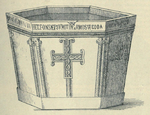| Zagreb Cathedral | |
|---|---|
| Cathedral of the Assumption of Mary | |
Croatian: Katedrala Uznesenja Blažene Djevice Marije i svetih Stjepana i Ladislava | |
 Zagreb Cathedral before the 2020 earthquake | |
| 45°48′52″N 15°58′47″E / 45.81444°N 15.97972°E | |
| Location | Zagreb |
| Country | Croatia |
| Denomination | Roman Catholic |
| History | |
| Status | Cathedral |
| Relics held | Sarcophagus of Blessed Aloysius Stepinac, Croatian martyrs Petar Zrinski and Fran Krsto Frankopan, whose bones were transferred from Wiener Neu Stadt in 1919 A.D., Ivan Antun Zrinski, Eugen Kvaternik etc |
| Architecture | |
| Functional status | Under reconstruction |
| Heritage designation | Register of Cultural Goods of Croatia |
| Designated | 2013 |
| Architect(s) | Hermann Bollé (last reconstruction) |
| Style | Gothic (original) Gothic Revival (19th century reconstructions) |
| Years built | Mid-13th century 1880–1906 (reconstruction/additions) |
| Specifications | |
| Number of spires | 2 |
| Spire height | 108 m (354 ft) |
| Bells | 5 (North Tower) 3 (South Tower)[1] |
| Administration | |
| Archdiocese | Zagreb |
| Clergy | |
| Archbishop | Dražen Kutleša |
| Native name Zagrebačka katedrala (Croatian) | |
| Location | Zagreb, Croatia |
| Architect | Hermann Bollé (last reconstruction) |
| Governing body | Zagrebačka katedrala |
| Type | Movable cultural good |
| Designated | March 9, 2013[2] |
| Reference no. | P-3621 |
| Protected assets | Plenarium and crucifix from the cathedral treasury |
| Part of a series on the |
| Catholic Church in Croatia |
|---|
 |
The Zagreb Cathedral (officially the Cathedral of the Assumption of the Blessed Virgin Mary and Saints Stephen and Ladislav), is a Catholic cathedral in Kaptol, Zagreb. It is the second tallest building in Croatia and the most monumental sacral building of Gothic architecture southeast of the Alps.[3]
The church is one of the most important symbols of Zagreb and Croatia, and in 2013 it entered in the Register of Cultural Goods of Croatia. It is dedicated to the Assumption of Mary and to king-saints Stephen and Ladislaus. The cathedral is typically Gothic, as is its sacristy, which is of great architectural value. Its prominent spires are considered to be landmarks as they are visible from most parts of the city. The cathedral is 108.4 meters high, making it one of the tallest churches in the world. Due to 2020 Zagreb earthquake, one of its two spires was damaged, so the cathedral is under reconstruction until further notice.
- ^ "Zvona zagrebačke katedrale" [Bells of the Zagreb Cathedral]. Glas Koncila (in Croatian). Archived from the original on August 17, 2011.
- ^ Register of Cultural Goods of Croatia. "Izvod iz registra kulturnih dobara Republike Hrvatske br. 01/10 - Lista preventivno zaštićenih dobara" [Excerpt from the register of cultural goods of the Republic of Croatia No. 01/10, List of preventively protected goods]. Narodne novine (in Croatian). Ministry of Culture (Croatia).
- ^ Gavrilović, Feđa (January 12, 2012). "Razbijene zastarjele predrasude" [Obsolete prejudices shattered]. Vijenac (in Croatian). No. 466. Matica hrvatska. ISSN 1330-2787. Retrieved April 7, 2018.

